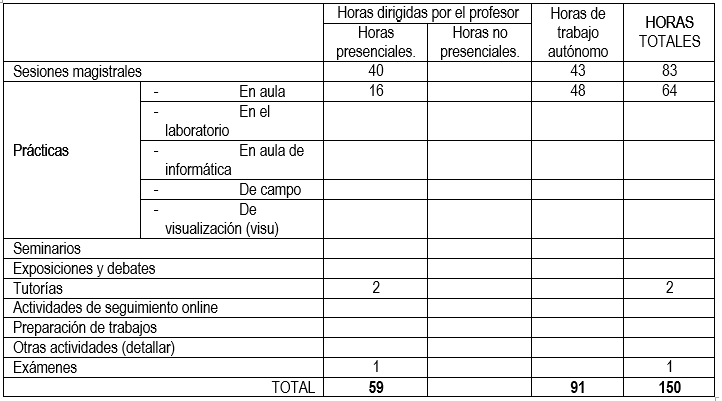INTERNATIONAL RELATIONS
GRADO EN ESTUDIOS GLOBALES/GLOBAL STUDIES
Curso 2018/2019
1. Subject Information
(Date last modified: 14-09-18 10:18)- Code
- 109003
- Plan
- 290
- ECTS
- 6.00
- Type
- Basic
- Year
- 1
- Duration
- First semester
- Language
- ENGLISH
- Area
- DERECHO INTERNACIONAL PÚBLICO Y RELACIONES INTERN.
- Departament
- Derecho Público General
- Virtual platform
Professor Information
- Profesor/Profesora
- Daniel González Herrera
- Group/s
- Único
- Centre
- Fac. Derecho
- Office
- 227
- Office hours
- Daniel González Herrera: Martes, miércoles, de 10h a 12h Polly Ruth Polak: Martes, miércoles, de 10h a 12h
- Web address
- http://campus.usal.es/~derechointernacionalpublico
- daniglez@usal.es
- Phone
- extensión 1665
- Professor
- Polly Ruth Polak
- Group/s
- Único
- Centre
- Fac. Derecho
- Office
- 225
- Office hours
- -
- Web address
- https://produccioncientifica.usal.es/investigadores/157343/detalle
- pollypolak@usal.es
- Phone
- 923294400 Ext. 1673
2. Association of the subject matter within the study plan
Curricular area to which the subject matter pertains.
International Relations
Purpose of the subject within the curricular area and study plan.
This subject has an essential role for the learning process of students and the acquisition of the necessary knowledge to understand the evolution of the international society. This subject is also essential in order to pass other subjects with an international profile.
Professional profile.
The contents and techniques of this subject are essential not only for professionals who specialize in international issues (diplomats, personnel of international institutions, etc.), but also are necessary in the training of any political scientist, civil servant of the administration, etc.
3. Prerequisites
No prerequisites are established to take the subject.
4. Learning objectives
This subject is aimed to analyse the international society and the main actors who can exercise influence in the international arena.
Studying this module will allow students to understand the evolution that the social and international environment has undergone throughout the history as well as to become familiar with the main challenges to which our society faces these days. Students will acquire great knowledge which will be necessary for understanding the main international actors’ behaviour and the future evolution of the International society.
At the end of the course the student will have acquired a series of basic skills which will make him or her capable of developing a reflexing and critic attitude in relation to several problems and challenges that affect the International society.
5. Contents
Theory.
|
I. INTRODUCTION: THE DISCIPLINE 1. The discipline of International Relations: between utopia and reality. 2. Theoretical perspectives: realism, neoliberal institutionalism, constructivism, postmodernism, feminism, etc. 3. The question of method: sociological approaches, psychological approaches, quantitative approaches, historical methods and case study methods. II. THE INTERNATIONAL SYSTEM: THE NEED FOR DYNAMIC APPROACHES 4. The international society: the current international scene (old and new). 5. The role of Public International Law: theory and praxis. 6. International actors: concept and typology. 7. State and sovereignty: a revisited approach. 8. International organizations: a reflection of global interdependence. 9. Transnational actors: NGOs and transnational companies. III. THE EUROPEAN UNION: BRIDGING THE BOUNDARIES 10. Peculiarities of European Governance: the Law as a driving force for supranational integration in Europe. 11. The internal action of the European Union: from the internal market to the monetary union and the European Area of Freedom, Security and Justice. 12. The external action of the European Union: commercial, diplomatic, foreign and defence powers of the EU. 13. Brexit and the European Union: one of the current challenges of the EU (and the Member States). IV. PARADIPLOMACY IN EUROPE: THE ROLE OF SUBNATIONAL ENTITIES 14. The external action in European federal states: the German model of Bundesländer. 15. The external action in Spanish decentralized State: the atypical (and problematic) model of Comunidades Autónomas. V. THE NEW AGENDA: THE ERA OF GLOBALIZATION 16. The (new) international economic agenda: more inequality? 17. The (new) international military agenda: the end of Pax Americana? 18. The international environmental agenda: reality or fiction? 19. International migrations: a truly international undertaking? 20. Terrorism and International Relations: clash of civilizations? 21. Religion and international politics: bridge between cultures or confrontation? |
22. Nationalism, ethnicity and populism: a risk for liberal democracy?
Practice.
The following list of practices is indicative:
- Historical evolution of international relations.
- The end of the cold war and the new global order.
- International actors and subjects.
- The EU internal and external action.
- Paradiplomacy.
- Terrrorism and international relations.
6. Competences acquired
Basic / General.
Básicas: CB1, CB2, CB3, CB4. Generales: A1, A3, A4, A5.
Specific.
B7, B11, B12, B13
7. Teaching methods
The proposed teaching method will be based on a combination of theoretical classes with a practical approach to the reality of international society. In doing so, dialogue with the students will be fostered with the aim of developing in them the ability to expose and defend reasoned arguments on international issues. During the explanations, references will be made to practical examples of the current international society with the aim of contextualizing the theoretical framework. Practical teaching will be based on the analysis of cases or the reading of texts that will be available on the Studium platform. It is advisable to keep abreast of the international news.
8. Anticipated distribution of the use of the different teaching methods

9. Resources
Reference books.
- BAYLIS, J., SMITH, S. and OWENS, P. (2014) The Globalization of World Politics: An introduction to international relations. Oxford: Oxford University Press.
- CARLSNAES, W.E., SIMMONS, B. A. and RISSE, T. (eds) (2012) Handbook of International Relations. London: Sage.
- GRIFFITHS, M. (ed) (2007) International Relations Theory for the Twenty-First Century: An introduction. London: Routledge.
- REUS-SMIT, C. and SNIDAL, D. (2010) The Oxford Handbook of International Relations. Oxford: Oxford University Press.
- SHIRAEV, E. and ZUBOK, V. (2015) International Relations. Oxford: Oxford University Press.
10. Assessment
Assessment criteria.
The assessment instruments will be the following:
- Passing the exam. The students can choose the modality of the exam: written or oral examination (70 % of the final mark).
- Hand in the case studies and a active participation in practical and theoretical classes and seminars (30 %).
Guidelines in the case of failing the subject.
The requisites for the second exam are the same of those for the ordinary call.


